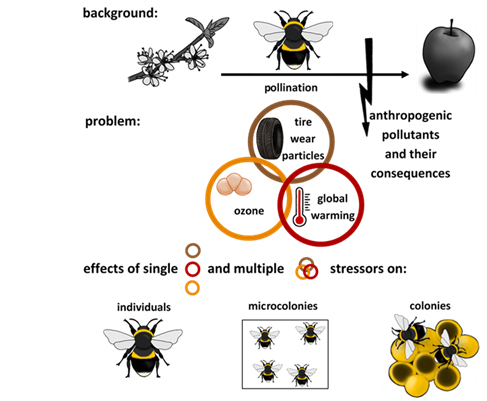Team > M. Sc. Gwen Büchner
 M. Sc. Gwen Büchner
M. Sc. Gwen Büchner

Faculty of Biology, Chemistry & Earth Sciences
Population Ecology
PhD project (funded by the doctoral scholarship and the Marianne-Plehn-Program of the Studienstiftung des deutschen Volkes)
Pollinators threatened by global change: Effects of ozone, tire wear particles and heat stress on the buff-tailed bumblebee (Bombus terrestris)

Pollinating insects are important providers of ecosystem services whose diversity and abundance are currently declining as a result of the biodiversity crisis. Anthropogenic pollution is one of the main drivers of their decline. To date, however, the effects of important anthropogenic pollutants and their resulting stressors on pollinator health have scarcely been studied.
In my project, I am investigating the effects of ozone, tire wear particles and heat stress both individually and in combination (as multiple stressors) on the health of the buff-tailed bumblebee (Bombus terrestris) as a pollinator. I will analyse the health effects at the individual as well as colony level.
1. Ozone
Anthropogenically induced elevated tropospheric ozone concentrations have a negative impact on human health. In the same way, they could also be dangerous for pollinators and damage e.g. respiratory tissues.
2. Tire wear particles
In Bavaria (Germany), tire wear particles account for 19 % of PM10 emissions (PM10 = particulate matter with a diameter < 10 µm) from road traffic. Tire wear particles contain (besides rubber) heavy metals, phenolic compounds and a number of other potentially toxic substances that can be harmful to pollinators after oral/respiratory ingestion.
3. Heat stress
Climate change is currently increasing the frequency of hot extremes and the temperatures of these extremes also increase. As bumblebees are considered to be cold-adapted, the investigation of the health effects of heat stress on their health is particularly relevant.
4. Multiple stressors
In their natural environment, pollinators are simultaneously exposed to a variety of different stressors. Single stressors can therefore lead to only minor health effects in isolated experiments. With multiple stressors, however, not only additive but also synergistic effect strengths might be observed. In order to consider the complexity of the environment in experiments, I will also investigate the interaction of multiple stressors.

Faculty of Biology, Chemistry & Earth Sciences
Population Ecology
Publications
2024
Gwen Büchner, Torsten Hothorn, Heike Feldhaar, Christian von Hoermann, Tomáš Lackner, Janine Rietz, Jens Schlüter, Oliver Mitesser, M. Eric Benbow, Marco Heurich, Jörg Müller: Ecological drivers of carrion beetle (Staphylinidae: Silphinae) diversity on small to large mammals. In: Ecology and Evolution, 14 (2024). - .
doi:10.1002/ece3.70203
Amelie Wierer, Christian von Hoermann, M. Eric Benbow, Christiane Büchner, Heike Feldhaar, Christian Fiderer, Oliver Mitesser, Janine Rietz, Jens Schlüter, Johannes Zeitzler, Tomáš Lackner, Claus Bässler, Marco Heurich, Jörg Müller: Mechanisms determining the multi-diversity of carrion visiting species along a gradient of carrion body mass. In: Oecologia, 206 (2024). - S. 115-126.
doi:10.1007/s00442-024-05611-1

Faculty of Biology, Chemistry & Earth Sciences
Population Ecology
M. Sc. Gwen Büchner
Doctoral student
Animal Ecology I - Population Ecology
Building NW I, Room 5.0 01 07
University of Bayreuth
Universitätsstr. 30
95447 Bayreuth
Phone: +49 (0) 921 55 2647
Fax: +49 (0) 921 55 2784
E-mail: Gwen.Buechner@uni-bayreuth.de

